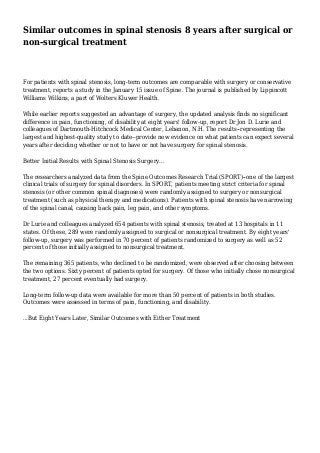Similar outcomes in spinal stenosis 8 years after surgical or non-surgical treatment
•
1 gostou•186 visualizações
For patients with spinal stenosis, long-term outcomes are comparable with surgery or conservative tr...
Denunciar
Compartilhar
Denunciar
Compartilhar
Baixar para ler offline

Recomendados
Recomendados
Mais conteúdo relacionado
Destaque
Destaque (20)
Product Design Trends in 2024 | Teenage Engineerings

Product Design Trends in 2024 | Teenage Engineerings
How Race, Age and Gender Shape Attitudes Towards Mental Health

How Race, Age and Gender Shape Attitudes Towards Mental Health
AI Trends in Creative Operations 2024 by Artwork Flow.pdf

AI Trends in Creative Operations 2024 by Artwork Flow.pdf
Content Methodology: A Best Practices Report (Webinar)

Content Methodology: A Best Practices Report (Webinar)
How to Prepare For a Successful Job Search for 2024

How to Prepare For a Successful Job Search for 2024
Social Media Marketing Trends 2024 // The Global Indie Insights

Social Media Marketing Trends 2024 // The Global Indie Insights
Trends In Paid Search: Navigating The Digital Landscape In 2024

Trends In Paid Search: Navigating The Digital Landscape In 2024
5 Public speaking tips from TED - Visualized summary

5 Public speaking tips from TED - Visualized summary
Google's Just Not That Into You: Understanding Core Updates & Search Intent

Google's Just Not That Into You: Understanding Core Updates & Search Intent
The six step guide to practical project management

The six step guide to practical project management
Beginners Guide to TikTok for Search - Rachel Pearson - We are Tilt __ Bright...

Beginners Guide to TikTok for Search - Rachel Pearson - We are Tilt __ Bright...
Unlocking the Power of ChatGPT and AI in Testing - A Real-World Look, present...

Unlocking the Power of ChatGPT and AI in Testing - A Real-World Look, present...
Similar outcomes in spinal stenosis 8 years after surgical or non-surgical treatment
- 1. Similar outcomes in spinal stenosis 8 years after surgical or non-surgical treatment For patients with spinal stenosis, long-term outcomes are comparable with surgery or conservative treatment, reports a study in the January 15 issue of Spine. The journal is published by Lippincott Williams Wilkins, a part of Wolters Kluwer Health. While earlier reports suggested an advantage of surgery, the updated analysis finds no significant difference in pain, functioning, of disability at eight years' follow-up, report Dr Jon D. Lurie and colleagues of Dartmouth-Hitchcock Medical Center, Lebanon, N.H. The results--representing the largest and highest-quality study to date--provide new evidence on what patients can expect several years after deciding whether or not to have or not have surgery for spinal stenosis. Better Initial Results with Spinal Stenosis Surgery... The researchers analyzed data from the Spine Outcomes Research Trial (SPORT)--one of the largest clinical trials of surgery for spinal disorders. In SPORT, patients meeting strict criteria for spinal stenosis (or other common spinal diagnoses) were randomly assigned to surgery or nonsurgical treatment (such as physical therapy and medications). Patients with spinal stenosis have narrowing of the spinal canal, causing back pain, leg pain, and other symptoms. Dr Lurie and colleagues analyzed 654 patients with spinal stenosis, treated at 13 hospitals in 11 states. Of these, 289 were randomly assigned to surgical or nonsurgical treatment. By eight years' follow-up, surgery was performed in 70 percent of patients randomized to surgery as well as 52 percent of those initially assigned to nonsurgical treatment. The remaining 365 patients, who declined to be randomized, were observed after choosing between the two options. Sixty percent of patients opted for surgery. Of those who initially chose nonsurgical treatment, 27 percent eventually had surgery. Long-term follow-up data were available for more than 50 percent of patients in both studies. Outcomes were assessed in terms of pain, functioning, and disability. ...But Eight Years Later, Similar Outcomes with Either Treatment
- 2. In "as-treated" analysis of the randomized study, surgery provided better outcomes through four years. But with longer follow-up, the difference between treatments narrowed. From six to eight years, outcomes were not significantly different between surgical and nonsurgical treatment. In contrast, in the observational study, the advantage of surgery remained stable from five to eight years. This may reflect greater differences in the initial characteristics of the two groups, Dr Lurie and coauthors believe. Patients without available follow-up data were older, sicker, and had worse outcomes in the first two years, with either treatment. "The long-term outcomes are therefore likely to be somewhat over- optimistic on average in both groups," the researchers write, "but the comparison between surgical and non-operative outcomes appears likely to be un-biased." Both treatments were safe. Of all patients undergoing surgery, 18 percent had repeat surgery for recurrent spinal stenosis within eight years. The results have important implications for discussing the expected long-term outcomes of treatment for spinal stenosis, Dr Lurie and coauthors believe. While surgery provides better outcomes for the first several years, the results of surgical and nonsurgical treatment appear to converge during longer-term follow-up.
- 3. While some groups of patients who initially opt for surgery may continue to do better over time, those who choose nonsurgical treatment can do quite well even out to eight years. The researchers note that, with either treatment, patients with spinal stenosis can expect to have some pain and reduced functioning, compared to people in the general population of similar age. http://www.medicalnewstoday.com/releases/287878.php